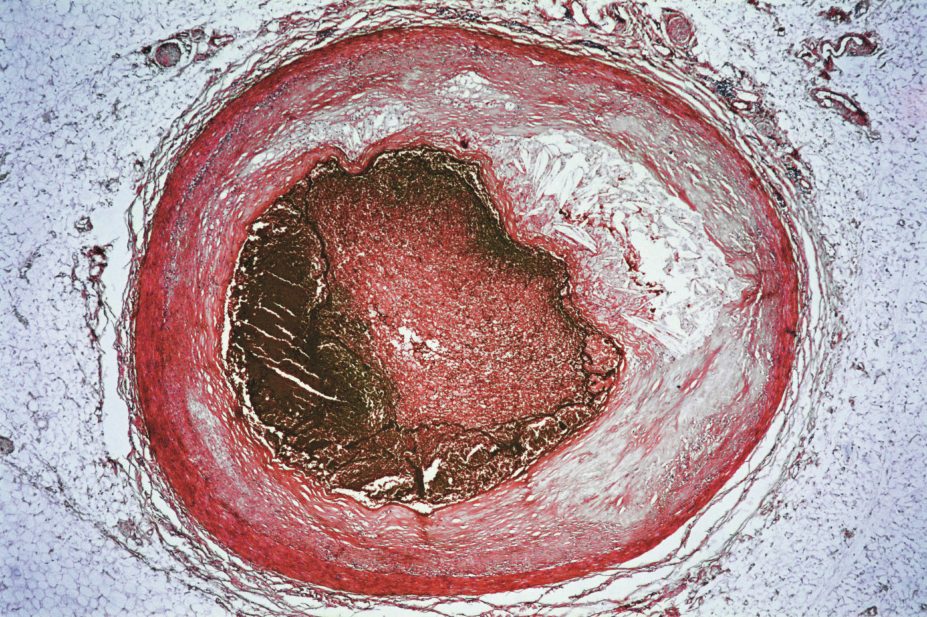
Biophoto Associates / Science Photo Library
Patients with atherosclerotic cardiovascular disease (ASCVD) receiving high-intensity statins — including those aged over 75 years — have a lower risk of death than those on a lower-intensity statin, according to new research. The survival rate was highest in patients given the maximum dose of higher intensity statins compared with lower doses.
The researchers based their findings on an analysis of the relationship between the intensity of statin therapy and one-year cardiovascular mortality among 509,766 adult patients.
“We found an inverse graded association between intensity of statin therapy and mortality,” say the researchers, led by Paul Heidenreich, professor of medicine and health research at Stanford University in California. “These findings suggest there is a substantial opportunity for improvement in the secondary prevention of ASCVD through optimisation of intensity of statin therapy.”
The patients, aged between 21 and 84 years, were registered with the US Veterans Health Administration — the United States’ largest integrated health care system — between April 2013 and April 2014. The patients, the majority of whom (499,598) were men and whose mean age was 68 years, were followed up after an average of 492 days. Some 29.6% received high-intensity statins (such as atorvastatin 40–80mg or rosuvastatin 20–40mg); 45.6% were given moderate-intensity statins (such as pravastatin 40–80 mg) and 6.7% received low-intensity statins (such as simvastatin 10mg); 18.2% were not on any statin treatment.
The researchers, who reported their findings in JAMA Cardiology
[1]
(online, 9 November 2016), found a “graded” association between patients’ intensity of statin therapy and mortality. For patients taking high-intensity treatment, the one-year mortality rate was 4.0%; for those receiving moderate-intensity therapy it was 4.8%; and for low-intensity treatment the rate was 5.7%. For those taking no statins, the one-year mortality rate was 6.6% (P<0.001).
Further analysis revealed that the hazard ratio (HR) for mortality was 0.91 (95% confidence interval 0.88-0.93) for those receiving high-intensity drugs compared with those receiving moderate-intensity statins. For patients aged 76 to 84 years, the hazard ratio was 0.91 (95% CI 0.87-0.95).
Patients treated with maximal doses of high-intensity statins had lower mortality (HR 0.90; 95% CI 0.87-0.94) compared with those receiving submaximal doses.
Sotiris Antoniou, consultant pharmacist in cardiovascular medicine at Barts Health NHS Trust in London, says the findings support earlier clinical trial data, as well as guidance from the National Institute for Health and Care Excellence — England’s health technology assessment body — which states that patients with established cardiovascular disease should be prescribed a high-intensity statin.
“For common practice, that is atorvastatin 40mg/80mg daily,” he points out. “But what is important to note [from this study] is that even with high intensity, there is a graded response, such that atorvastatin 80mg gave a greater reduction in mortality than 40mg atorvastatin.”
As a result, Antoniou suggests that anyone admitted to hospital with cardiovascular disease, irrespective of age, should be offered the option of starting therapy with 80mg atorvastatin. The dose of atorvastatin can then be reduced if any myalgia is experienced or if the patient is considered high risk, “as opposed to starting on 40mg atorvastatin on the pretence of being considered high-risk, without any discussion with the patient”.
“This choice of course needs to be balanced to ensure support for long-term adherence,” he says.
The need to involve patients in discussions about their treatment was also highlighted by Jeremy Pearson, associate medical director at the British Heart Foundation. “While this research confirms the greater benefit of more intensive treatment, decisions on dosage require conversations between patients and their doctors,” he says.
References
[1] Rodriguez F, Maron DJ, Knowles JW et al. Association between intensity of statin therapy and mortality in patients with atherosclerotic cardiovascular disease. JAMA Cardiology 2016. doi: 10.1001/jamacardio.2016.4052

